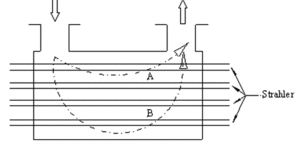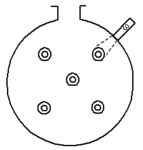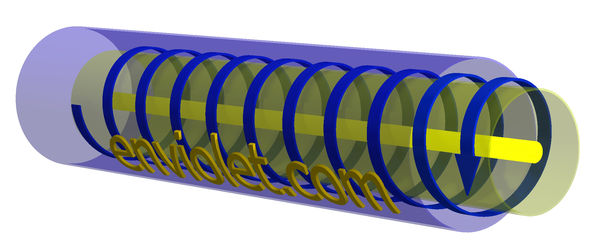uv reactors, photo-oxidation, advanced oxidation (aop), recycling & engineering
for industrial use
Theoretical Background of UV Disinfection
Before the technical description of UV reactors for UV disinfection, we will briefly explain the physical relations of UV disinfection:
During an extensive R&D project of the German government a great number of germs (bacteria, virus, yeast, etc.) and their deactivation by UV light of the wave length 254 nm (main emission of a mercury low pressure lamp) was investigated. They focused on the incident UV dose dependent on the deactivation rate. This work lead to the fixing of the dose of UV at 400 J/m² for drinking water disinfection, because this dose showed a reliable reduction of germs for at least more than 99,99% of the relevant types of bacteria.
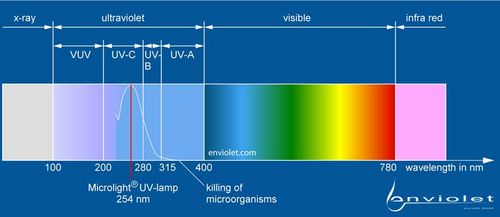
UV reactors have to be able to penetrate water with a given minimum dose.
The absorption of UV light in water, the geometrical construction of the irradiation chamber, the residence time in the irradiated area and the residence time distribution of the water are important parameters.
The law of Lambert-Beer describes the reduction of intensity of the UV light passing through the irradiated zone:

I0 is the initial intensity [in W] and I is the intensity at the location x.
SAC (Spectral Absorption Coefficient ) is an optical property of the liquid with the dimension [1/length]. For x1 this means:

The irradiance (Dosis) is a physical function of the intensity (Intensität), the residence time (Zeit) and the irradiated area (Fläche):

Relation of SAC and transmission at different path length for UV-light for sterilization (wavelength 254 nm).
| SAC in 1/m | T (1cm) in % | T (5cm) in % | T (10cm) in % |
| 0,5 | 99 | 95 | 90 |
| 1 | 98 | 90 | 82 |
| 2 | 95 | 79 | 63 |
| 5 | 89 | 56 | 31 |
| 10 | 79 | 30 | 9 |
| 15 | 70 | 17 | 3 |
| 20 | 62 | 9 | 1 |
| 25 | 56 | 6 | 0,5 |
| 30 | 50 | 3 | 0,1 |
The layout of UV reactors is the foundation of the design. The residence time in a conventional UV reactor is a very complex figure. This is why an exact calculation of the dose is not possible for conventional UV reactors. Therefore, enviolet only uses UV reactors with a rotational flow. A central quartz tube separates lamp and water, and in the ring space around this tube (and the horizontal axis) rotates the liquid (see Fig. below).
Exact calculations can be based on this design.
Visualization of the rotational flow typical for the UV disinfection reactors of enviolet. The narrow residence time behavior of the UV reactor leads to a well defined and calculable flow.
The advantages of the rotational flow are:
- The rotational flow allows a simple calculation of the important parameters. This makes enviolet the only supplier of customer fit designs.
- The residence time behavior is very narrow. All volume segments are irradiated with exactly the same dose.
- The rotating liquid is abrasive to the central quartz sleeve, to prevent settlements.
- The high turbulence leads to a very good mixing making the disinfection more effective.
- The integral intensity of all lamps in the enviolet reactor system is constantly monitored. This means that the corresponding signal represents the actual state of UV emission perfectly.
The integral monitoring of all UV lamps in one reactor leads to a reliable signal of the UV dose inside the enviolet MicroUV® reactor.
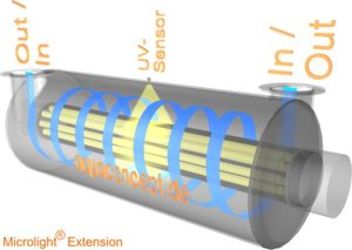
Reactors constructed in the way depicted below, should not be used, as they show the following disadvantages:
- The path A follows a residence time that is too short for the disinfection to be complete. On path B the residence time is too long, and energy and lamp life time is wasted.
- A by-pass flow can be observed, which has to be compensated by higher power. This causes higher running costs due to additional energy consumption and additional spare lamps.
- Furthermore particles sediment in the conventional reactors on the lamps, which leads to complex and sensible mechanical cleaning equipment.
- Another disadvantage of the conventional reactors is the limited function of the UV sensors. Typically the signal of only one lamp is measured as a reference. This can lead to a number of defaults: e.g. all lamps being old, but only the measured one being new; in this case, the dose at the sensor is significantly higher than the real value inside the reactor. This results in a state which seems safe but is highly unsatisfactory.
